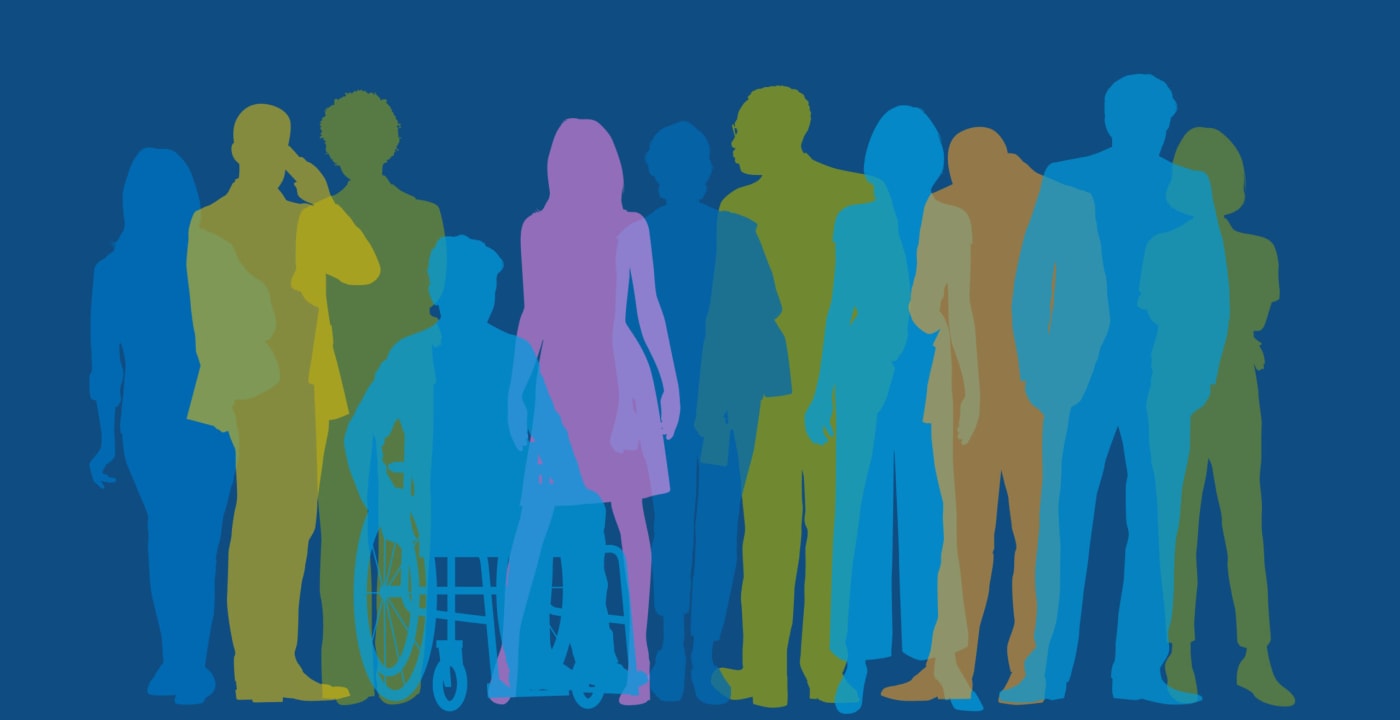LGBTQ+ health equity should be the rule, not the exception

At a glance
- Unique disparities include discrimination, physical and mental health conditions, poverty and reproductive health challenges
- Health care systems should engage in diversity, equity and inclusion work to combat biases
- Growing access to affirming providers and care spaces is key to reducing LGBTQ+ health disparities
At MultiCare, we are committed to working toward health equity — ensuring all people have access to quality health care regardless of age, race, ethnicity, gender identity, religion, sexual orientation, ability, socioeconomic status or location.
But we also recognize the reality that longstanding biases and barriers embedded in the health care system, and our society, can prevent people from accessing the care they need.
In this series — inspired in part by society’s growing awareness that not everyone has the same chance to be healthy — we take a deeper look at the disparities that impact our patients and how we as health care providers and community members can reduce those disparities and improve the health and well-being of all.
Maternity care for bisexual women of color
Bisexual women and women of color have long experienced challenges in maternal and perinatal health care.
From bi negativity and bisexual erasure to racial stereotypes and adverse health outcomes, this is a reality Deana Williams, (she/her), PhD, MPH, has found in her work as a research investigator at the MultiCare Institute for Research and Innovation.
What she doesn’t know, though, is what bisexual women of color experience when seeking and accessing this type of care. And that’s largely because the research community isn’t doing enough to accurately represent them.
“In current research, bisexual women of color are vastly underrepresented and often aggregated with other sexual minority women,” Williams says. “Women of color who are bisexual are experiencing disparities at even greater levels than their white queer counterparts.”
Dr. Williams is leading a study funded by the National Institutes of Health to capture the voices and lived experiences of these patients. She hopes to spark changes that will result in affirming, culturally conscious care for all birthing people.
Health care disparities come in many forms
This case study is just one example of the health disparities faced by the LGBTQ+ community. Discrimination based on gender identity and sexual orientation — especially when coupled with race, age and socio-economic status — can play a significant role in equitable access to care.
For example, LGBTQ+ adolescents are more likely to experience bullying, and without access to affirming and culturally competent intervention and treatment, the risk of suicide increases, according to the U.S. Department of Health and Human Services.
The Trevor Project reports LGBTQ+ youth are more than four times likely to attempt suicide than their peers.
“Queer people don’t genetically have predispositions that lead to things like substance abuse or suicidality,” says Joseph Angel, MD, (he/him), a family medicine/obstetrics and LGBTQ+ care provider at MultiCare Tacoma Family Medicine. “It stems from society and the unwelcoming spaces.”
Sometimes these health disparities come from simpler things, such as patient forms with only two gender options, a receptionist refusing to use a chosen name, or a health care provider making assumptions about a patient’s sexual health.
Other times, disparities are based on decades-long systemic issues that have been ingrained in health care education and operations.
“We are skin before we are gender, and skin changes so much over a lifetime. If that’s always shifting, we should have the ability to shift in other ways.”
LGBTQ+ health care has long been dictated by gay white men and focused on sexual health. Although it’s a necessary group to care for, others have been left out, Dr. Angel explains.
Women who have sex with women, for example, have higher rates of reproductive cancer, he says. They’re more likely to miss cancer screenings and less likely to be pregnant and/or breastfeed, which is thought to provide beneficial hormones that reduce the risk of many cancers.
Gay men also have higher rates of HPV-related cancers, which they don’t typically get screened for, Dr. Angel adds.
Many of these challenges come from a lack of LGBTQ+ competency, says Esteban Herevia (he/him), former Spokane Pride president/CEO. Doctors and other health care providers have good intentions, but may not understand the impact enough.
An organization could update its intake process to gather sexual orientation, gender identity and pronoun (SOGI-P) information but may not do so in a respectful manner, such as asking in front of others in the waiting room. It’s not meant to be intrusive, but it doesn’t create a respectful space, Herevia says.
Unique issues for older LGBTQ+ adults and youth
Health disparities are a longstanding issue for the LGBTQ+ community.
As a group, older LGBTQ+ patients experience unique economic and health disparities, including poverty and physical and mental health conditions from a lifetime of stressors. They’re less open with providers about their sexual and gender identity because they feel unsafe, and are more likely to live in isolation, according to the American Psychological Association.
Queer youth face mental health challenges not only from discrimination and societal pressure — but also the struggle to receive affirming and appropriate care due to a lack of transportation, financial resources or parental support.
“In general, there are misconceptions that queer youth are confused,” says Daniel Ensley (he/him), development and partnerships specialist at Oasis Youth Center in Tacoma.
It’s easy for people to focus on struggles like suicidal ideation, substance use and sexual assault, he explains.
“It’s extremely sexualized because when people think about those who are not straight, for some reason all they can focus on is that single difference and kind of forget we are whole people,” Ensley says. “[Sex education] is not talking about consent, boundaries and communication enough, so when youth are put in situations because of discrimination, stigma and lack of support, they’re at risk for victimization.”
Room for improvement in LGBTQ+ care
Health care organizations should be engaging in diversity, equity and inclusion (DEI) work, says Dr. Angel. On a social level, we should all work to break down our biases. But providers often want to believe they have no biases without putting in the work, he adds.
“It’s really the responsibility of the provider to educate themselves on the disparities that exist in different populations,” he says. “Sometimes they expect their patients to do that for them, but that’s not their role.”
The LGBTQ+ community has made great strides in equality over the past few decades, so it’s easy for people to assume the work is done, Dr. Angel says. With that mindset, patients can struggle to find affirming, reliable providers. Plus, many LGBTQ+ individuals distrust health care spaces and hesitate to seek care because of negative experiences they’d had.
During Herevia’s time with Spokane Pride, he was brought into the Washington State University College of Medicine to lead a competency course with second-year medical students and faculty. The most productive conversation that day came out of a disagreement.
People mistakenly think LGBTQ+ health care providers are trying to change a person’s genetic makeup, he explains. But that’s not possible and isn’t necessary to affirm someone’s gender identity.
“We are skin before we are gender, and skin changes so much over a lifetime,” Herevia says. “If that’s always shifting, we should have the ability to shift in other ways.”
What MultiCare is doing for the LGBTQ+ community
While we have more to do, MultiCare has made strides in improving the care and experience of LGBTQ+ patients.
In 2019, MultiCare began collecting SOGI-P information during intake, says Jennifer Vigil (she/her), MultiCare Inland Northwest health equity and outreach program manager.
Staff are still perfecting the process, she says, such as when and where to ask such questions, and addressing some people’s frustration about why they or their children are being asked.
“Being an LGBTQ+ competent provider should be the rule, not the exception. Every single person who is interacting with patients should understand a queer or gender-expansive person might be in the room.”
It’s important to acknowledge those feelings, Vigil says, but also teach people that these questions go beyond a federal mandate — they’re rooted in providing an affirming space, especially for those at higher risk for suicide.
MultiCare is also developing a directory of LGBTQ+ affirming doctors and other health care providers so patients can more easily identify those who specialize in their specific health needs.
MultiCare has also:
- Created all-gender bathrooms in our hospitals
- Developed inclusive policies and procedures for LGBTQ+ patients and staff
- Sponsored and participated in regional Pride celebrations
- Updated electronic medical records systems to be trans inclusive
- Established the MultiCare Rockwood HIV Critical Care Clinic
- Expanded access to gender-affirming surgery at MultiCare Deaconess Hospital through community provider partnerships
Achieving health equity is a group effort
Uncertainty is one of the biggest things faced by Oasis Youth Center’s members, who are 11- to 24-year-olds, Ensley says. They ask, “Is my clinic LGBTQ+ competent or a safe place to disclose my gender?”
Navigating health care systems is challenging enough as adults, he says. Youth may not know what’s covered or where to look, especially if they don’t have support at home.
This needs to be a priority on the personal, organizational and community level, Dr. Angel says. We need to make time for education and hold one another accountable.
Advancing an organization’s stance on things like anti-racism and queer equity — and transparency around how they’re achieving such goals — is key, adds researcher Dr. Williams.
“Being an LGBTQ+ competent provider should be the rule, not the exception. Every single person who is interacting with patients should understand a queer or gender-expansive person might be in the room,” she says. “I think there’s a lot of people willing and wanting to learn but don’t know how to go about it.”
The National LGBTQIA+ Health Education Center outlines 10 strategies organizations can follow to create inclusive health care environments, such as inclusive forms, partnering with LGBTQ+ organizations and providing and following up on training.
The community can also play a role by supporting equitable access to quality, affordable care and providing access to reliable, easy-to-read information.
Equity impacts everyone
As Dr. Williams digs into her research, she reminds herself that LGBTQ+ health is not just about disparities.
“It’s important to research the disparities to address them, but also, queer people are thriving and resilient,” she says. “They also have these positive ways they’ve learned to navigate health care systems and cultivate joy. I want to bring that joy to the forefront.”
Whether that’s celebrating a bisexual woman of color as she welcomes her first child into the world, ensuring a queer teen has access to a provider who affirms and understands their specific needs, or providing a safe place for an older LGBTQ+ adult to receive care, there are many ways our community can come together for healing and a healthy future.
What's next
- Find an LGBTQ+ affirming provider near you
- Learn more about the advancements in PrEP availability and effectiveness
- How we use your preferred identifiers to improve your care




